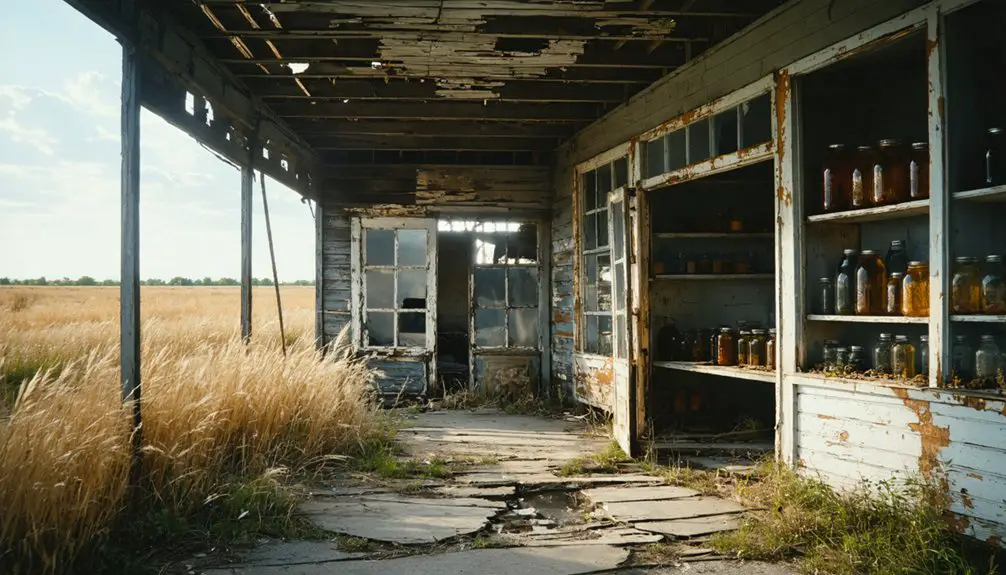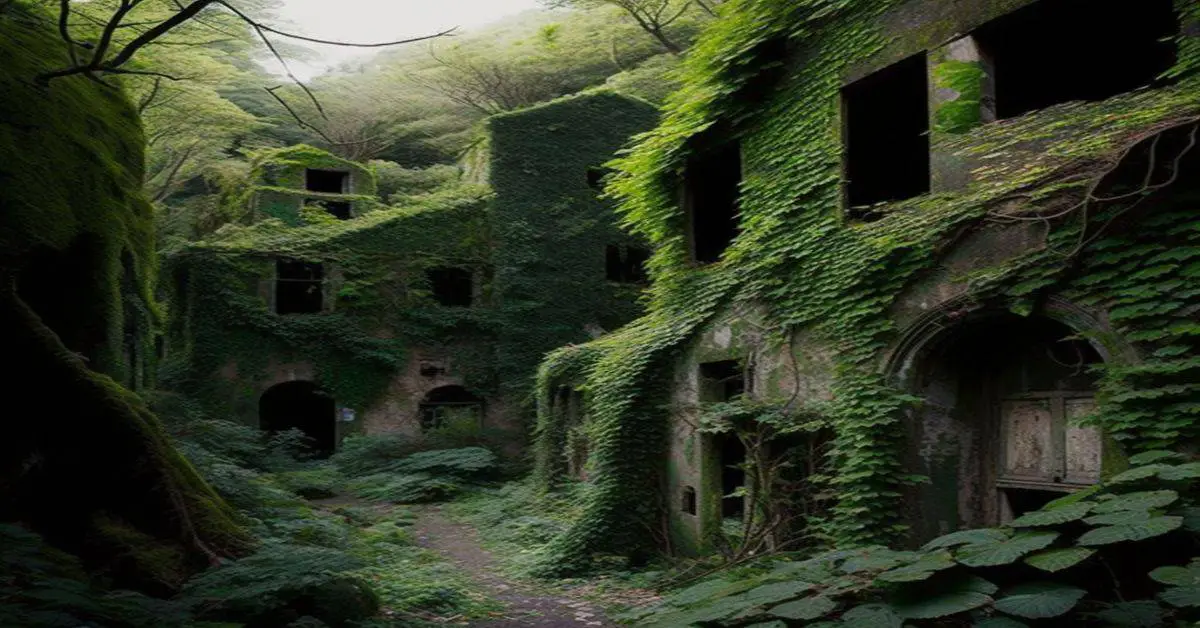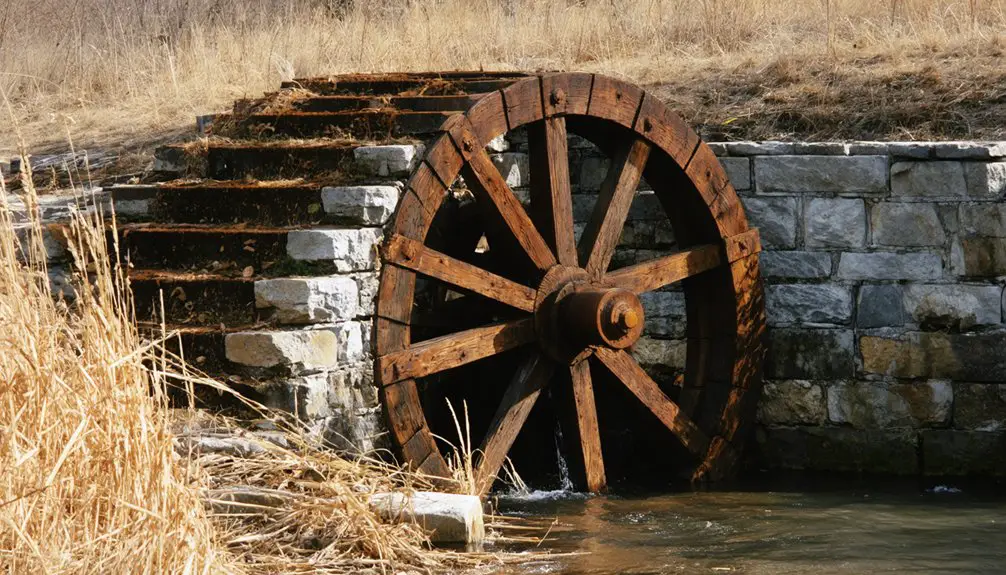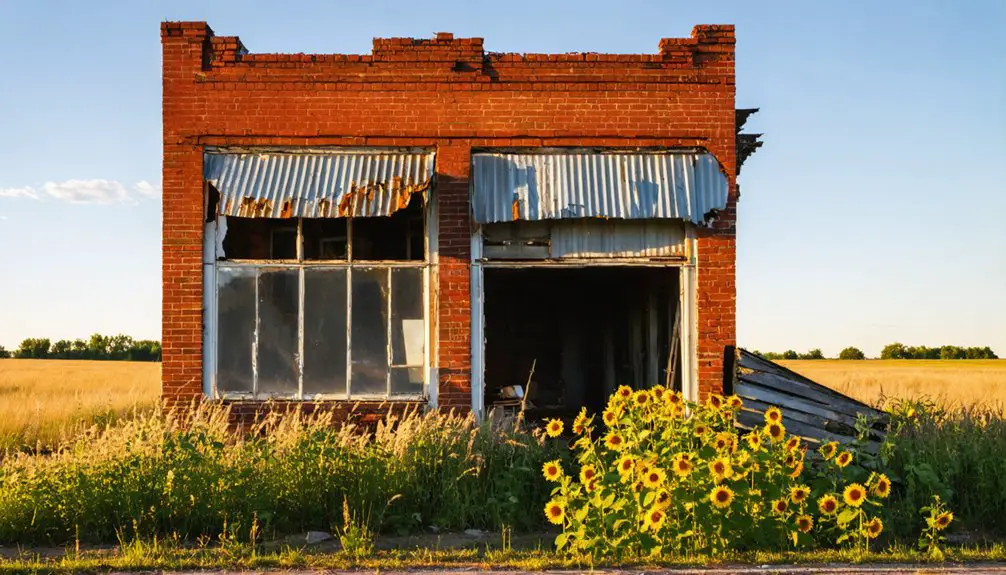You’ll find Muncie, Kansas along the Kansas River’s north bank, where it thrived as a railway hub from the 1860s through the mid-1900s. The town grew around the Union Pacific Railroad depot and interurban trolley station, becoming famous for an 1874 James-Younger Gang train heist. After Highway 32’s construction in the 1960s bypassed the area, Muncie’s businesses closed, though scattered historic buildings and active rail lines still tell tales of its bustling past.
Key Takeaways
- Muncie transitioned from a bustling railroad hub to a ghost town after the Highway 32 bypass diverted traffic in the 1960s.
- The town’s decline accelerated when local businesses, including cafes and grocery stores, closed due to reduced customer traffic.
- County zoning restrictions north of Highway 32 prevented commercial development, further contributing to Muncie’s abandonment.
- Historical remnants include old Union Pacific and Interurban trolley depots, marking its past as a significant transportation center.
- Muncie lost its independent identity after being incorporated into Kansas City, Kansas, though it remains a distinct neighborhood.
From Munsee Settlement to Railway Hub
While the exact location of permanent Munsee settlements remains uncertain, this eastern Kansas community’s name stems from the Munsee subgroup of the Lenape Native Americans who originally inhabited the region.
You’ll find that early settler communities established themselves along existing Native American trails, following patterns typical of Kansas’s mid-to-late 19th century territorial expansion. Like thousands of other Kansas settlements, many towns appeared and vanished as population relocated to more promising locations.
The town’s transformation began with the arrival of the Kansas City, Leavenworth & Western Railway in 1899. This electric passenger trolley line marked a pivotal shift from Munsee origins to railway significance, spurring rapid development.
The railway’s 1899 arrival transformed Muncie from Native American territory into a thriving transportation hub along Kansas’s expanding frontier.
The population grew from just 40 residents in 1910 to about 100 by 1930, as the rail station turned Muncie into a bustling stop between Bonner Springs and Kansas City. The town gained notoriety when the infamous James-Younger Gang orchestrated a daring train robbery in 1874, stealing thousands in currency and passenger valuables.
The James-Younger Gang’s Famous Train Heist
As winter descended on December 8, 1874, the James-Younger Gang orchestrated one of their most daring heists at the Muncie train depot.
Six outlaws forced railroad workers to create a blockade using wooden ties, then bound and gagged them to prevent any warning signals. When the Kansas Pacific Railroad train halted at the obstruction, the gang swiftly took control, holding passengers at gunpoint while targeting the baggage and express cars. The gang demonstrated their expertise as skilled gunslingers throughout the robbery.
The train robbery netted around $30,000, cementing the gang’s reputation and drawing intense pursuit from the Pinkerton Agency. The gang managed to escape with a total of $55,000 in valuables.
The gang impact extended beyond the immediate theft – their selective sparing of women and working men, identified by calloused hands, created a complex legacy.
While some viewed them as Confederate heroes, others saw dangerous criminals who’d forever changed Muncie’s story.
Life Along the Railroad Tracks
During the early 1860s, the Union Pacific Railroad transformed Muncie from empty prairie into a bustling transit point by constructing a depot that would shape the town’s destiny for nearly a century.
A single railroad depot carved a thriving town from untamed prairie, forever altering Muncie’s path through history.
You’d have found a tight-knit railroad community growing steadily around those tracks, reaching about 100 residents by 1930. The depot hummed with activity as travelers and locals mingled at nearby cafes, grocery stores, and repair shops. Located at 40°11′48″N latitude, this strategic position made it an ideal transportation hub.
Originally operating as the Leavenworth, Pawnee and Western, the railroad began its Kansas operations in 1855, setting the foundation for towns like Muncie along its route.
An electric trolley line connected you to Kansas City and Leavenworth, while telegraph services kept you linked to the wider world.
But freedom of movement shifted with the times. When Highway 32 bypassed Muncie in the 1960s and the interurban railway closed, economic decline set in.
The once-vibrant businesses closed, residents moved away, and the railroad community that had defined Muncie for generations faded into memory.
Early Transportation and Economic Growth
If you’d visited Muncie in its early days, you’d have found a bustling railroad hub where the Union Pacific’s freight yards and the Kansas City, Leavenworth & Western interurban trolley converged to serve regional commerce.
Moses Grinter’s ferry crossing at Muncie had previously established the town’s importance in local transportation, enabling settlers and military personnel to cross the Kansas River.
Like nearby High Bluffs along the Kansas River, Muncie’s elevated terrain created natural challenges for transportation and development.
The 1899 construction of the trolley station sparked Muncie’s growth from 40 residents in 1910 to approximately 100 by 1930, while supporting a small but essential business district that served both rail workers and passengers.
The town’s growth mirrored Kansas’s broader railway expansion, which reached 9,367 miles of track by 1917.
Railroad Hub Development
Three major railroad developments transformed Muncie, Kansas into an essential transportation hub during the 1860s.
You’ll find Union Pacific’s construction of a depot, Kansas Pacific’s westward expansion through Wyandotte, and the strategic placement of rail lines along the Kansas River’s north bank at the heart of this railroad expansion.
This growth aligned with Kansas Territory’s broader railway evolution, as federal land grants helped stimulate railroad construction across the region by offering 6,400 acres per mile of track built.
Interurban Trolley Service
Building upon Muncie’s railroad foundations, the arrival of electric trolley service in 1899 marked a new chapter in the town’s transportation story. The Kansas City, Leavenworth & Western company constructed an essential line connecting you directly to Kansas City and Leavenworth, transforming local mobility in southern Wyandotte County.
This trolley history proved significant to Muncie’s modest growth, as the town’s population expanded from 40 to 100 residents between 1910 and 1930. The affordable hourly service rates made transportation accessible to residents from all economic backgrounds.
The economic connections fostered by the interurban line supported a small but vibrant business district, including a cafe, mechanic, grocery, and hardware store. You’d find faster, more reliable transport than horse-drawn alternatives, with the trolley serving as a key link in the regional transportation network until its closure in 1957.
Ferry Crossing Commerce
Long before the railroads and trolleys transformed Muncie’s landscape, Moses Grinter’s ferry crossing on the Kansas River served as the region’s essential transportation hub.
You’d find his ferry operations at what became known as Delaware Crossing, connecting Fort Leavenworth to Fort Scott along the military road. This strategic location provided economic stimulation through Grinter’s trading post and the area’s first non-military post office.
The ferry didn’t just serve soldiers and traders – you’d see countless pioneers heading west to Oregon and California during the 1840s and 1850s.
Working alongside his Lenape wife Windagamen, Grinter’s enterprise bridged cultures while linking old Indian trails to commercial routes.
The ferry’s impact sparked development of surrounding settlements and business districts that would define early Muncie.
Highway 32’s Impact on Local Business
When Highway 32 bypassed Muncie to the north in the 1960s, it delivered a devastating blow to the town’s small business district.
You’d have found traffic volumes dropping dramatically as daily commuters and freight carriers chose the new route, abandoning the path through town. The impact triggered rapid business closures – the local café, mechanic, grocery store, and hardware shop all shuttered within a few years.
While surrounding areas along K-7 and K-32 corridors have flourished with new industrial developments like Amazon’s Distribution Center, Muncie’s economic decline continued.
County zoning policies restricted commercial development north of Highway 32 to primarily residential use, further limiting the town’s recovery options.
Today, traffic volumes ranging from 2,000 to 16,000 vehicles daily completely bypass what was once a thriving community.
Traces of a Once-Thriving Community
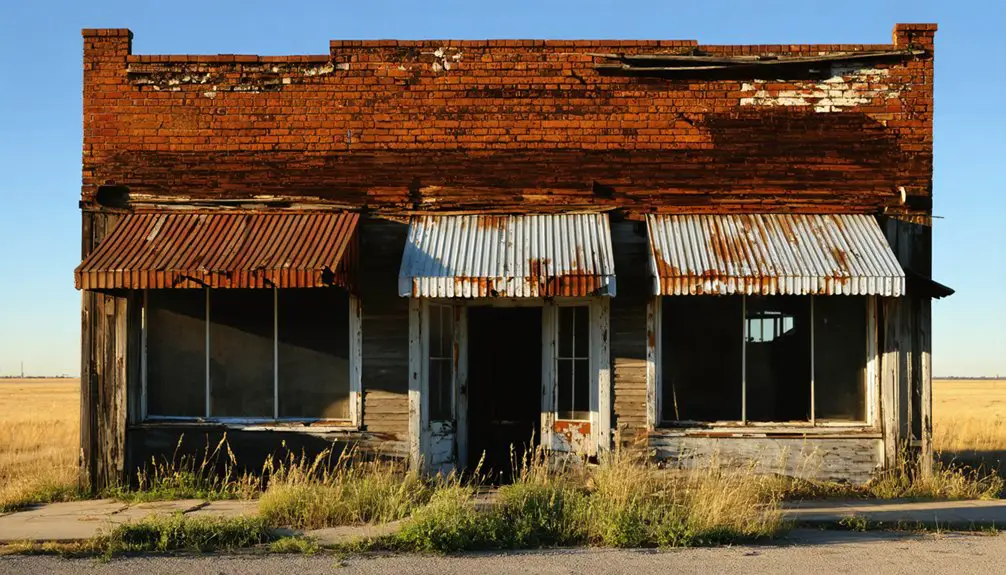
Today, scattered remnants of Muncie’s vibrant past dot the landscape within Kansas City’s expanded boundaries.
You’ll find the old Union Pacific and Interurban trolley depots standing as silent witnesses to the town’s transportation heritage, while Grinter Place, listed on the National Register of Historic Places, preserves the area’s pioneer spirit.
The community’s historical significance runs deep, from the Munsee band of the Lenape tribe’s original settlement to the dramatic 1874 James-Younger Gang train robbery.
You can still spot traces of this rich history in the weathered bricks of Grinter Place, where graffiti from May 1865 tells stories of those who came before.
Though the business district now stands largely abandoned, these physical remnants serve as powerful reminders of Muncie’s once-thriving community life.
Historical Buildings and Landmarks
Among Muncie’s most notable architectural heritage sites stand the iconic Union Pacific and Leavenworth Interurban Railroad depots, marking the town’s significance as a transportation hub in early Kansas.
These structures embody the architectural significance of Muncie’s golden era, when the town flourished as an essential stop along multiple rail lines.
While many buildings haven’t survived, you’ll find traces of historic preservation in these remaining landmarks:
- The Wentworth Cafe building site from the 1950s
- Remnants of the original business district
- The nearby Grinter Place State Historic Site
- The Delaware Crossing area where the Munsee band first settled
Today, these architectural vestiges serve as silent witnesses to Muncie’s transformation from a bustling railway town to a ghost town within Kansas City’s expanding boundaries.
Modern Legacy in Kansas City
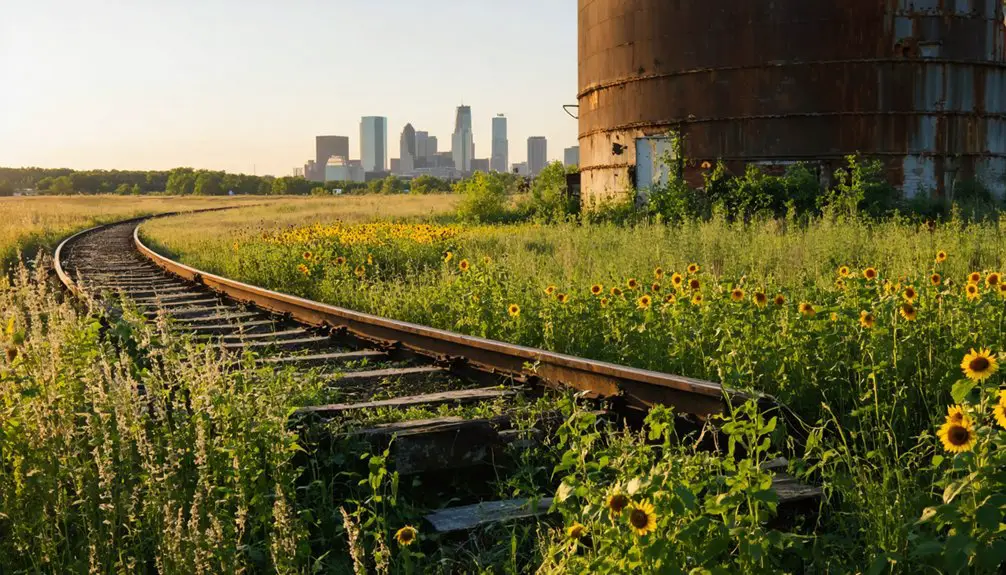
Though Muncie’s independent identity faded after its 1960s incorporation into Kansas City, Kansas, its legacy endures as a distinctive neighborhood along the Kansas River’s north bank.
Once a standalone town, Muncie lives on as a unique riverside community within Kansas City’s expanding borders.
You’ll find remnants of its past in the ghost town business district, where active rail lines still thunder through, echoing the area’s transportation heritage.
The urban integration of Muncie reflects a broader pattern of metropolitan expansion, while its cultural heritage lives on through its Munsee Delaware origins.
Today, you can trace this indigenous influence in local place names and commemorations throughout the region.
While highway bypasses and changing economics transformed the former railway town, Muncie’s story remains woven into Kansas City’s modern urban fabric through mixed-use development and historical markers.
Frequently Asked Questions
What Was the Population of Muncie During Its Peak Years?
You’ll find Muncie’s historical population reached its peak around 1930 with approximately 100 residents, up from about 40 in 1910. These demographics reflect its status as a small railroad station town.
Are There Any Remaining Descendants of Original Muncie Settlers Still Living Nearby?
Through miles of dusty records and descendant research, you’ll find some Grinter family connections remain in Wyandotte County, while most original settler families dispersed across Kansas City’s metro region over generations.
Did Any Famous People Besides the James-Younger Gang Visit Muncie?
You won’t find records of other famous visitors to Muncie besides the James-Younger Gang. Early settlers like Moses Grinter and Reverend Jesse Vogler were locally notable, but national celebrities didn’t frequent this Kansas town.
What Happened to the Original Munsee Native American Cemetery?
A dozen Munsee remains were unearthed during construction, showing how their cemetery history was erased. You’ll find their burial ground now lies beneath Mount Muncie Cemetery and National Military Home in Leavenworth County.
Can Visitors Explore the Ghost Town Ruins Today?
You can explore the abandoned ruins, as they’re publicly visible within Kansas City limits, but there aren’t formal exploration guidelines or facilities. Exercise caution since structures may be unsafe and unstable.
References
- https://theclio.com/entry/188110
- https://www.humanitieskansas.org/get-involved/kansas-stories/places/mining-for-stories-in-a-kansas-ghost-town
- https://www.geotab.com/ghost-towns/
- https://www.youtube.com/watch?v=OyBXD18P_j4
- https://freepages.rootsweb.com/~gtusa/history/usa/ks.htm
- http://kansasghosttowns.blogspot.com/2010/12/altering-railroad-broke-cash-city.html
- https://www.youtube.com/watch?v=UJWJx6Huow8
- https://dianastaresinicdeane.wordpress.com/2012/06/12/ghost-trains-on-the-low-plains-a-kansas-railroad-story/
- https://legendsofkansas.com/kansas-railroads/
- https://www.angelfire.com/mi2/jamesyoungergang/muncie.html
